Development of Person-Centred Care Plan for Albert Clarke: NURS2004
VerifiedAdded on 2022/08/14
|11
|2885
|23
Report
AI Summary
This report details a comprehensive care plan for Albert Clarke, a 72-year-old male admitted with an exacerbation of COPD. The care plan, developed using the nursing process, focuses on two primary nursing diagnoses: ineffective airway clearance and impaired gas exchange. The report includes thorough assessments, diagnostic considerations, and detailed planning for interventions such as monitoring respirations, encouraging fluid intake, and administering humidified oxygen. Implementation strategies encompass positioning, medication administration, and patient education. The evaluation section outlines expected outcomes, including improved lung sounds, normal oxygen saturation, and the patient's ability to participate in self-care. Furthermore, the report identifies the multidisciplinary team involved in Albert's care, including physicians, nurses, therapists, and educators, and discusses relevant ethical and legal considerations. The overall goal is to provide a holistic, person-centered approach to improve Albert's respiratory function and quality of life, highlighting the importance of effective communication, patient autonomy, and adherence to ethical standards.
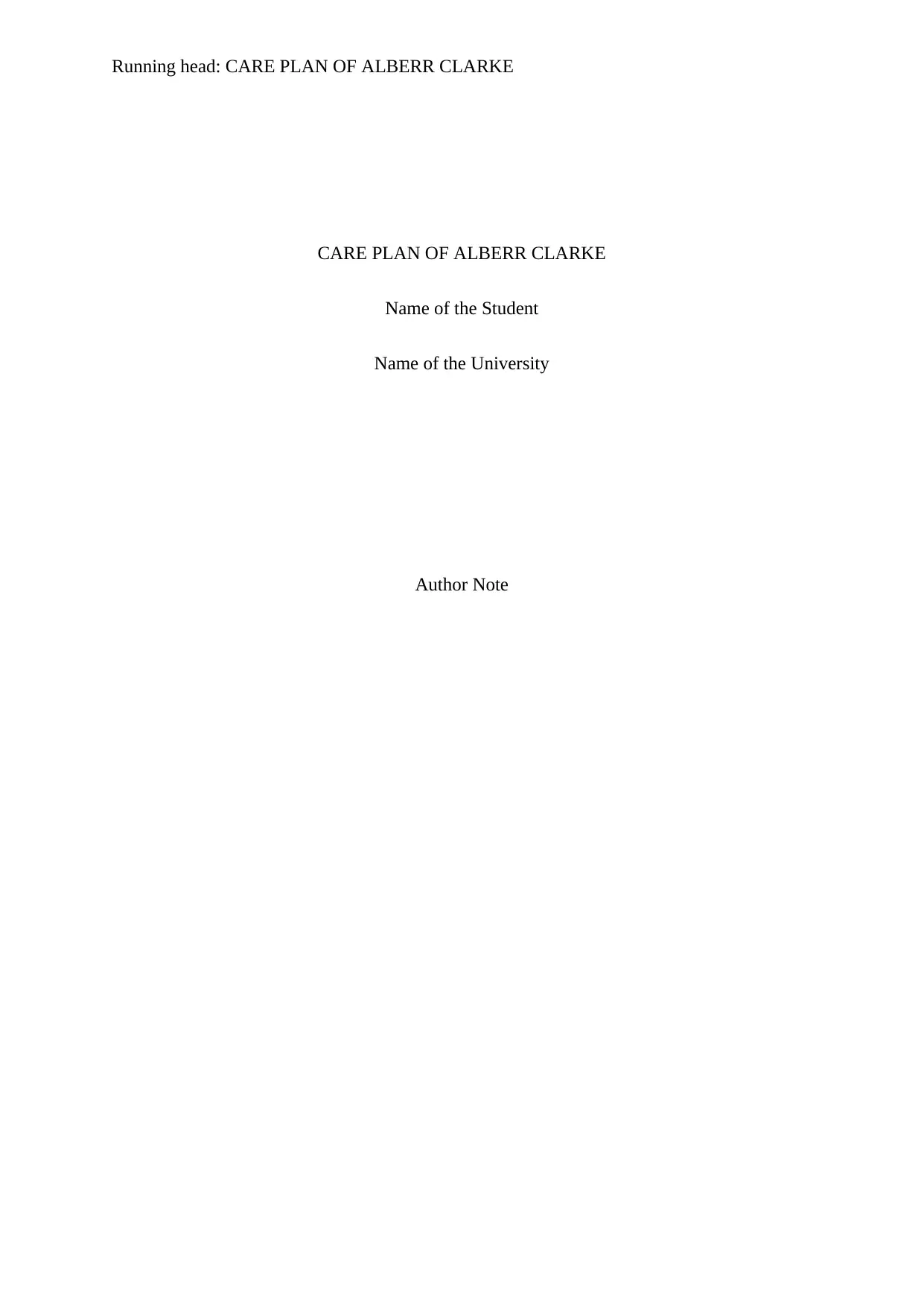
Running head: CARE PLAN OF ALBERR CLARKE
CARE PLAN OF ALBERR CLARKE
Name of the Student
Name of the University
Author Note
CARE PLAN OF ALBERR CLARKE
Name of the Student
Name of the University
Author Note
Paraphrase This Document
Need a fresh take? Get an instant paraphrase of this document with our AI Paraphraser
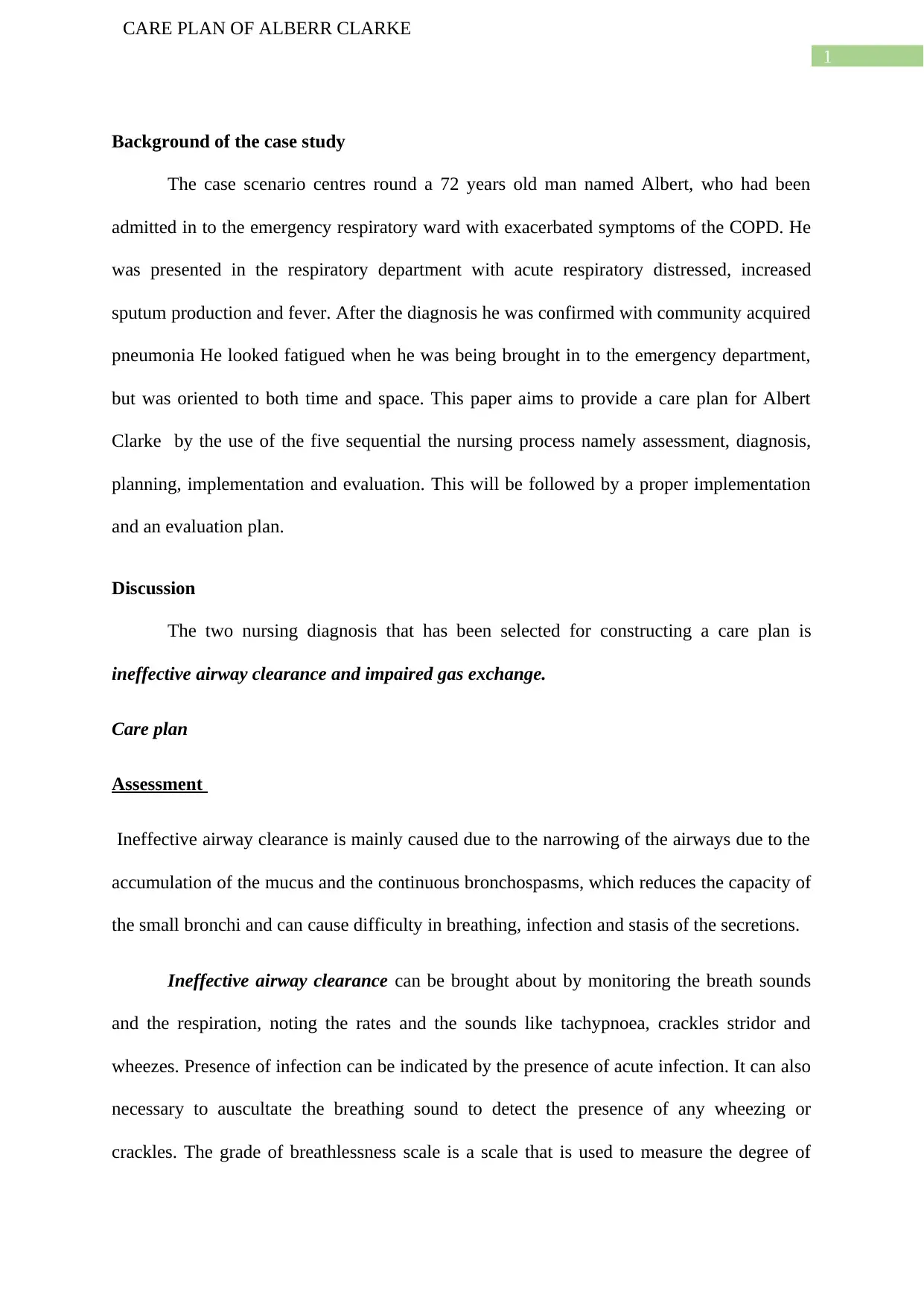
1
CARE PLAN OF ALBERR CLARKE
Background of the case study
The case scenario centres round a 72 years old man named Albert, who had been
admitted in to the emergency respiratory ward with exacerbated symptoms of the COPD. He
was presented in the respiratory department with acute respiratory distressed, increased
sputum production and fever. After the diagnosis he was confirmed with community acquired
pneumonia He looked fatigued when he was being brought in to the emergency department,
but was oriented to both time and space. This paper aims to provide a care plan for Albert
Clarke by the use of the five sequential the nursing process namely assessment, diagnosis,
planning, implementation and evaluation. This will be followed by a proper implementation
and an evaluation plan.
Discussion
The two nursing diagnosis that has been selected for constructing a care plan is
ineffective airway clearance and impaired gas exchange.
Care plan
Assessment
Ineffective airway clearance is mainly caused due to the narrowing of the airways due to the
accumulation of the mucus and the continuous bronchospasms, which reduces the capacity of
the small bronchi and can cause difficulty in breathing, infection and stasis of the secretions.
Ineffective airway clearance can be brought about by monitoring the breath sounds
and the respiration, noting the rates and the sounds like tachypnoea, crackles stridor and
wheezes. Presence of infection can be indicated by the presence of acute infection. It can also
necessary to auscultate the breathing sound to detect the presence of any wheezing or
crackles. The grade of breathlessness scale is a scale that is used to measure the degree of
CARE PLAN OF ALBERR CLARKE
Background of the case study
The case scenario centres round a 72 years old man named Albert, who had been
admitted in to the emergency respiratory ward with exacerbated symptoms of the COPD. He
was presented in the respiratory department with acute respiratory distressed, increased
sputum production and fever. After the diagnosis he was confirmed with community acquired
pneumonia He looked fatigued when he was being brought in to the emergency department,
but was oriented to both time and space. This paper aims to provide a care plan for Albert
Clarke by the use of the five sequential the nursing process namely assessment, diagnosis,
planning, implementation and evaluation. This will be followed by a proper implementation
and an evaluation plan.
Discussion
The two nursing diagnosis that has been selected for constructing a care plan is
ineffective airway clearance and impaired gas exchange.
Care plan
Assessment
Ineffective airway clearance is mainly caused due to the narrowing of the airways due to the
accumulation of the mucus and the continuous bronchospasms, which reduces the capacity of
the small bronchi and can cause difficulty in breathing, infection and stasis of the secretions.
Ineffective airway clearance can be brought about by monitoring the breath sounds
and the respiration, noting the rates and the sounds like tachypnoea, crackles stridor and
wheezes. Presence of infection can be indicated by the presence of acute infection. It can also
necessary to auscultate the breathing sound to detect the presence of any wheezing or
crackles. The grade of breathlessness scale is a scale that is used to measure the degree of
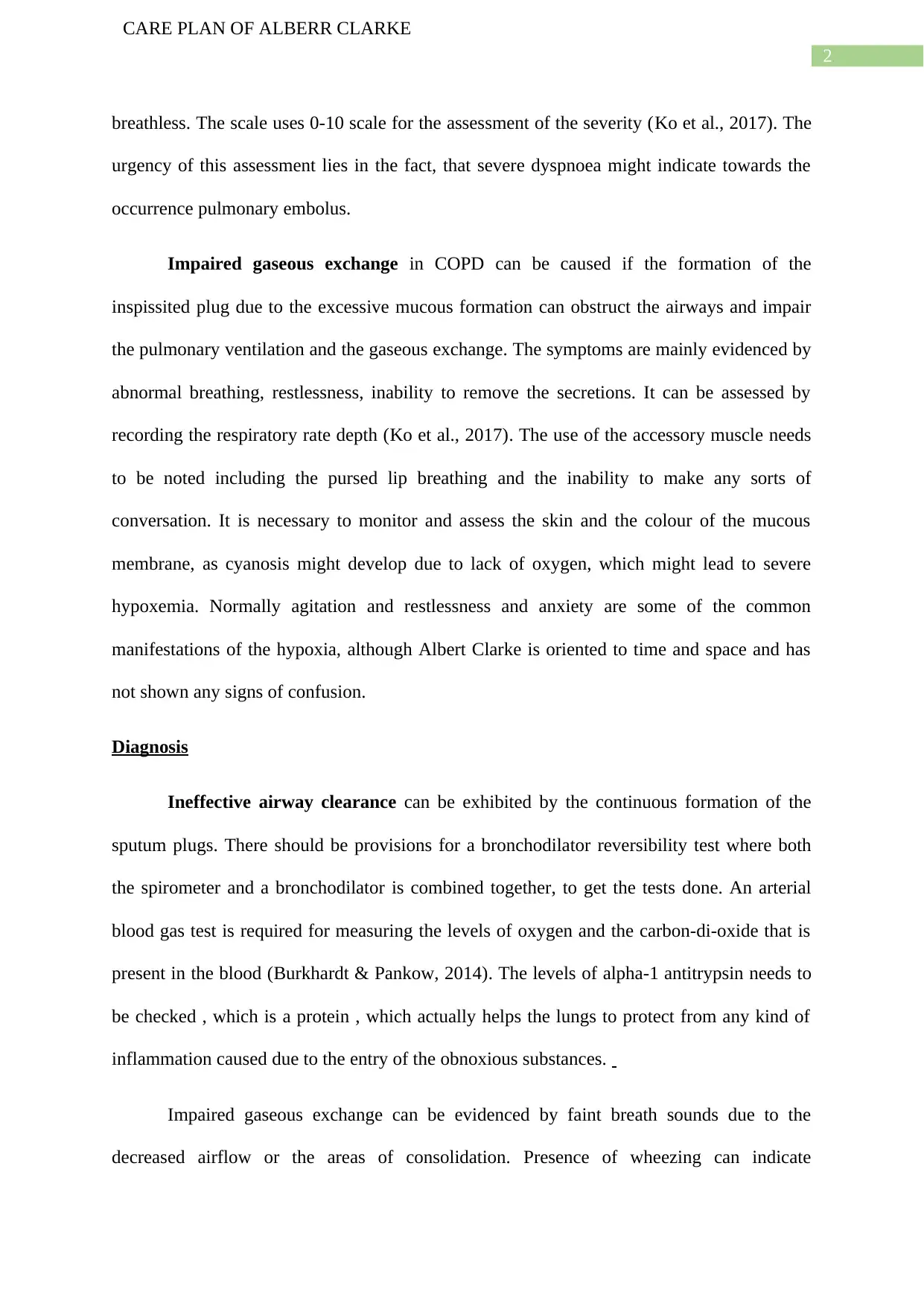
2
CARE PLAN OF ALBERR CLARKE
breathless. The scale uses 0-10 scale for the assessment of the severity (Ko et al., 2017). The
urgency of this assessment lies in the fact, that severe dyspnoea might indicate towards the
occurrence pulmonary embolus.
Impaired gaseous exchange in COPD can be caused if the formation of the
inspissited plug due to the excessive mucous formation can obstruct the airways and impair
the pulmonary ventilation and the gaseous exchange. The symptoms are mainly evidenced by
abnormal breathing, restlessness, inability to remove the secretions. It can be assessed by
recording the respiratory rate depth (Ko et al., 2017). The use of the accessory muscle needs
to be noted including the pursed lip breathing and the inability to make any sorts of
conversation. It is necessary to monitor and assess the skin and the colour of the mucous
membrane, as cyanosis might develop due to lack of oxygen, which might lead to severe
hypoxemia. Normally agitation and restlessness and anxiety are some of the common
manifestations of the hypoxia, although Albert Clarke is oriented to time and space and has
not shown any signs of confusion.
Diagnosis
Ineffective airway clearance can be exhibited by the continuous formation of the
sputum plugs. There should be provisions for a bronchodilator reversibility test where both
the spirometer and a bronchodilator is combined together, to get the tests done. An arterial
blood gas test is required for measuring the levels of oxygen and the carbon-di-oxide that is
present in the blood (Burkhardt & Pankow, 2014). The levels of alpha-1 antitrypsin needs to
be checked , which is a protein , which actually helps the lungs to protect from any kind of
inflammation caused due to the entry of the obnoxious substances.
Impaired gaseous exchange can be evidenced by faint breath sounds due to the
decreased airflow or the areas of consolidation. Presence of wheezing can indicate
CARE PLAN OF ALBERR CLARKE
breathless. The scale uses 0-10 scale for the assessment of the severity (Ko et al., 2017). The
urgency of this assessment lies in the fact, that severe dyspnoea might indicate towards the
occurrence pulmonary embolus.
Impaired gaseous exchange in COPD can be caused if the formation of the
inspissited plug due to the excessive mucous formation can obstruct the airways and impair
the pulmonary ventilation and the gaseous exchange. The symptoms are mainly evidenced by
abnormal breathing, restlessness, inability to remove the secretions. It can be assessed by
recording the respiratory rate depth (Ko et al., 2017). The use of the accessory muscle needs
to be noted including the pursed lip breathing and the inability to make any sorts of
conversation. It is necessary to monitor and assess the skin and the colour of the mucous
membrane, as cyanosis might develop due to lack of oxygen, which might lead to severe
hypoxemia. Normally agitation and restlessness and anxiety are some of the common
manifestations of the hypoxia, although Albert Clarke is oriented to time and space and has
not shown any signs of confusion.
Diagnosis
Ineffective airway clearance can be exhibited by the continuous formation of the
sputum plugs. There should be provisions for a bronchodilator reversibility test where both
the spirometer and a bronchodilator is combined together, to get the tests done. An arterial
blood gas test is required for measuring the levels of oxygen and the carbon-di-oxide that is
present in the blood (Burkhardt & Pankow, 2014). The levels of alpha-1 antitrypsin needs to
be checked , which is a protein , which actually helps the lungs to protect from any kind of
inflammation caused due to the entry of the obnoxious substances.
Impaired gaseous exchange can be evidenced by faint breath sounds due to the
decreased airflow or the areas of consolidation. Presence of wheezing can indicate
⊘ This is a preview!⊘
Do you want full access?
Subscribe today to unlock all pages.

Trusted by 1+ million students worldwide
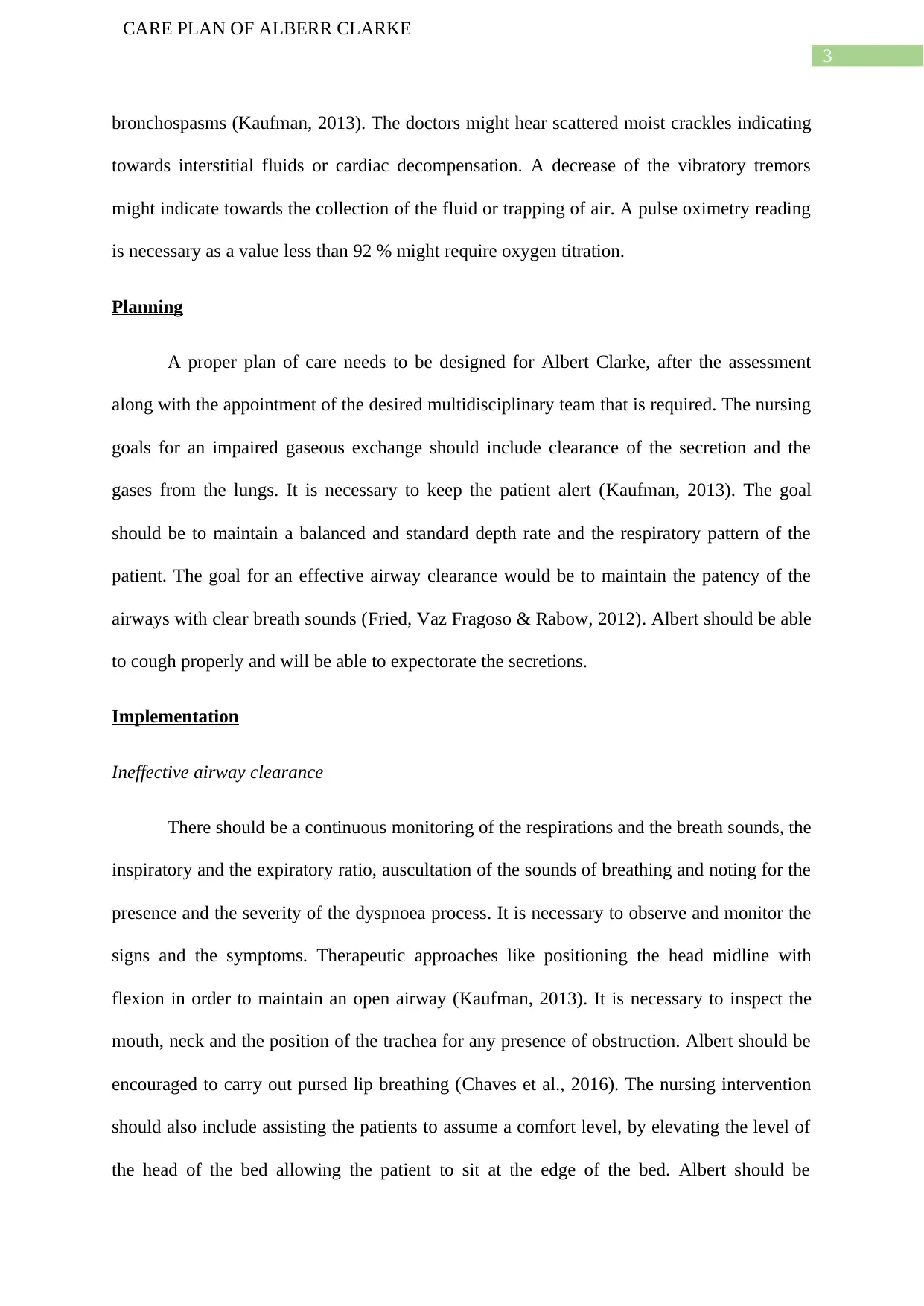
3
CARE PLAN OF ALBERR CLARKE
bronchospasms (Kaufman, 2013). The doctors might hear scattered moist crackles indicating
towards interstitial fluids or cardiac decompensation. A decrease of the vibratory tremors
might indicate towards the collection of the fluid or trapping of air. A pulse oximetry reading
is necessary as a value less than 92 % might require oxygen titration.
Planning
A proper plan of care needs to be designed for Albert Clarke, after the assessment
along with the appointment of the desired multidisciplinary team that is required. The nursing
goals for an impaired gaseous exchange should include clearance of the secretion and the
gases from the lungs. It is necessary to keep the patient alert (Kaufman, 2013). The goal
should be to maintain a balanced and standard depth rate and the respiratory pattern of the
patient. The goal for an effective airway clearance would be to maintain the patency of the
airways with clear breath sounds (Fried, Vaz Fragoso & Rabow, 2012). Albert should be able
to cough properly and will be able to expectorate the secretions.
Implementation
Ineffective airway clearance
There should be a continuous monitoring of the respirations and the breath sounds, the
inspiratory and the expiratory ratio, auscultation of the sounds of breathing and noting for the
presence and the severity of the dyspnoea process. It is necessary to observe and monitor the
signs and the symptoms. Therapeutic approaches like positioning the head midline with
flexion in order to maintain an open airway (Kaufman, 2013). It is necessary to inspect the
mouth, neck and the position of the trachea for any presence of obstruction. Albert should be
encouraged to carry out pursed lip breathing (Chaves et al., 2016). The nursing intervention
should also include assisting the patients to assume a comfort level, by elevating the level of
the head of the bed allowing the patient to sit at the edge of the bed. Albert should be
CARE PLAN OF ALBERR CLARKE
bronchospasms (Kaufman, 2013). The doctors might hear scattered moist crackles indicating
towards interstitial fluids or cardiac decompensation. A decrease of the vibratory tremors
might indicate towards the collection of the fluid or trapping of air. A pulse oximetry reading
is necessary as a value less than 92 % might require oxygen titration.
Planning
A proper plan of care needs to be designed for Albert Clarke, after the assessment
along with the appointment of the desired multidisciplinary team that is required. The nursing
goals for an impaired gaseous exchange should include clearance of the secretion and the
gases from the lungs. It is necessary to keep the patient alert (Kaufman, 2013). The goal
should be to maintain a balanced and standard depth rate and the respiratory pattern of the
patient. The goal for an effective airway clearance would be to maintain the patency of the
airways with clear breath sounds (Fried, Vaz Fragoso & Rabow, 2012). Albert should be able
to cough properly and will be able to expectorate the secretions.
Implementation
Ineffective airway clearance
There should be a continuous monitoring of the respirations and the breath sounds, the
inspiratory and the expiratory ratio, auscultation of the sounds of breathing and noting for the
presence and the severity of the dyspnoea process. It is necessary to observe and monitor the
signs and the symptoms. Therapeutic approaches like positioning the head midline with
flexion in order to maintain an open airway (Kaufman, 2013). It is necessary to inspect the
mouth, neck and the position of the trachea for any presence of obstruction. Albert should be
encouraged to carry out pursed lip breathing (Chaves et al., 2016). The nursing intervention
should also include assisting the patients to assume a comfort level, by elevating the level of
the head of the bed allowing the patient to sit at the edge of the bed. Albert should be
Paraphrase This Document
Need a fresh take? Get an instant paraphrase of this document with our AI Paraphraser
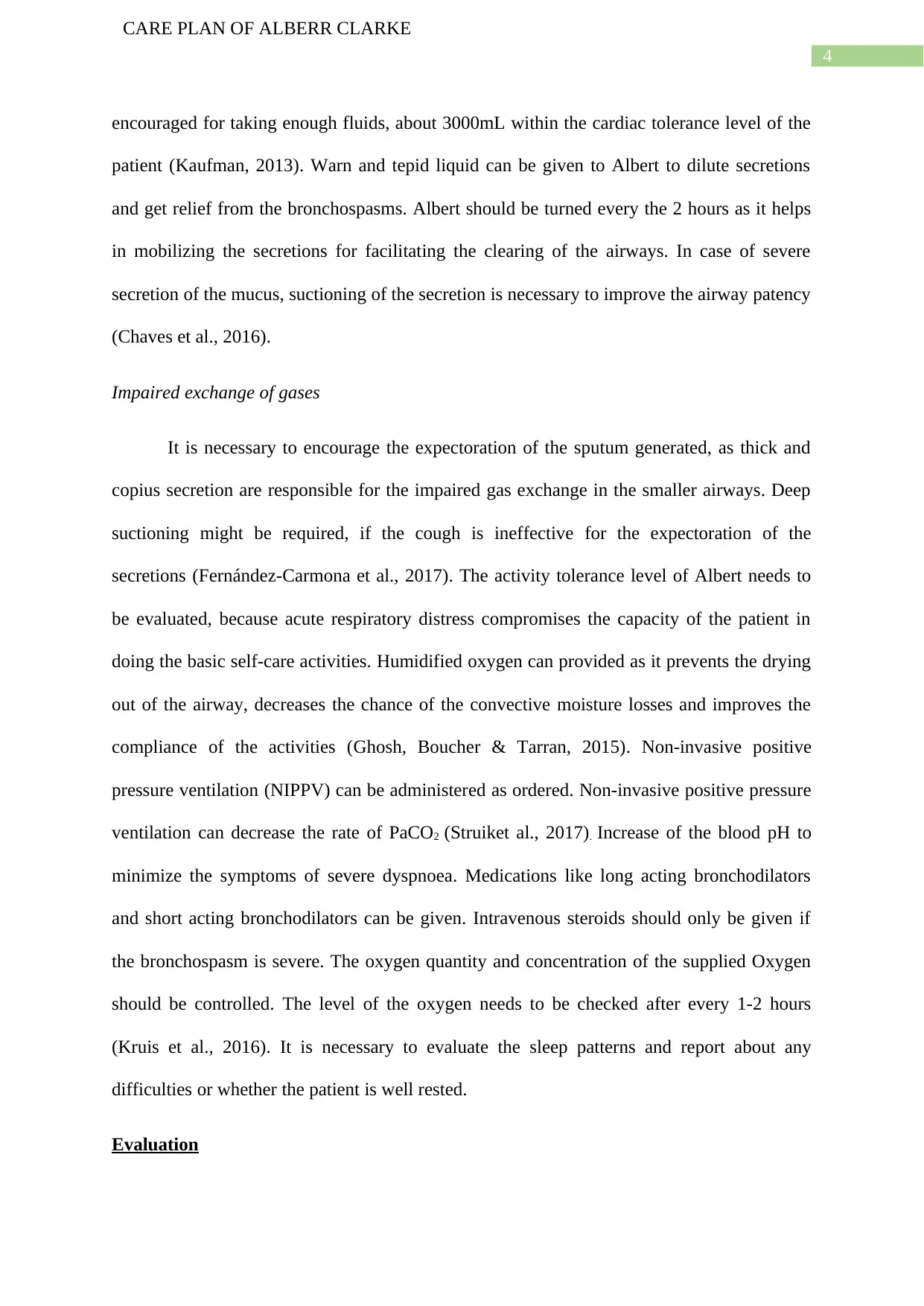
4
CARE PLAN OF ALBERR CLARKE
encouraged for taking enough fluids, about 3000mL within the cardiac tolerance level of the
patient (Kaufman, 2013). Warn and tepid liquid can be given to Albert to dilute secretions
and get relief from the bronchospasms. Albert should be turned every the 2 hours as it helps
in mobilizing the secretions for facilitating the clearing of the airways. In case of severe
secretion of the mucus, suctioning of the secretion is necessary to improve the airway patency
(Chaves et al., 2016).
Impaired exchange of gases
It is necessary to encourage the expectoration of the sputum generated, as thick and
copius secretion are responsible for the impaired gas exchange in the smaller airways. Deep
suctioning might be required, if the cough is ineffective for the expectoration of the
secretions (Fernández-Carmona et al., 2017). The activity tolerance level of Albert needs to
be evaluated, because acute respiratory distress compromises the capacity of the patient in
doing the basic self-care activities. Humidified oxygen can provided as it prevents the drying
out of the airway, decreases the chance of the convective moisture losses and improves the
compliance of the activities (Ghosh, Boucher & Tarran, 2015). Non-invasive positive
pressure ventilation (NIPPV) can be administered as ordered. Non-invasive positive pressure
ventilation can decrease the rate of PaCO2 (Struiket al., 2017). Increase of the blood pH to
minimize the symptoms of severe dyspnoea. Medications like long acting bronchodilators
and short acting bronchodilators can be given. Intravenous steroids should only be given if
the bronchospasm is severe. The oxygen quantity and concentration of the supplied Oxygen
should be controlled. The level of the oxygen needs to be checked after every 1-2 hours
(Kruis et al., 2016). It is necessary to evaluate the sleep patterns and report about any
difficulties or whether the patient is well rested.
Evaluation
CARE PLAN OF ALBERR CLARKE
encouraged for taking enough fluids, about 3000mL within the cardiac tolerance level of the
patient (Kaufman, 2013). Warn and tepid liquid can be given to Albert to dilute secretions
and get relief from the bronchospasms. Albert should be turned every the 2 hours as it helps
in mobilizing the secretions for facilitating the clearing of the airways. In case of severe
secretion of the mucus, suctioning of the secretion is necessary to improve the airway patency
(Chaves et al., 2016).
Impaired exchange of gases
It is necessary to encourage the expectoration of the sputum generated, as thick and
copius secretion are responsible for the impaired gas exchange in the smaller airways. Deep
suctioning might be required, if the cough is ineffective for the expectoration of the
secretions (Fernández-Carmona et al., 2017). The activity tolerance level of Albert needs to
be evaluated, because acute respiratory distress compromises the capacity of the patient in
doing the basic self-care activities. Humidified oxygen can provided as it prevents the drying
out of the airway, decreases the chance of the convective moisture losses and improves the
compliance of the activities (Ghosh, Boucher & Tarran, 2015). Non-invasive positive
pressure ventilation (NIPPV) can be administered as ordered. Non-invasive positive pressure
ventilation can decrease the rate of PaCO2 (Struiket al., 2017). Increase of the blood pH to
minimize the symptoms of severe dyspnoea. Medications like long acting bronchodilators
and short acting bronchodilators can be given. Intravenous steroids should only be given if
the bronchospasm is severe. The oxygen quantity and concentration of the supplied Oxygen
should be controlled. The level of the oxygen needs to be checked after every 1-2 hours
(Kruis et al., 2016). It is necessary to evaluate the sleep patterns and report about any
difficulties or whether the patient is well rested.
Evaluation
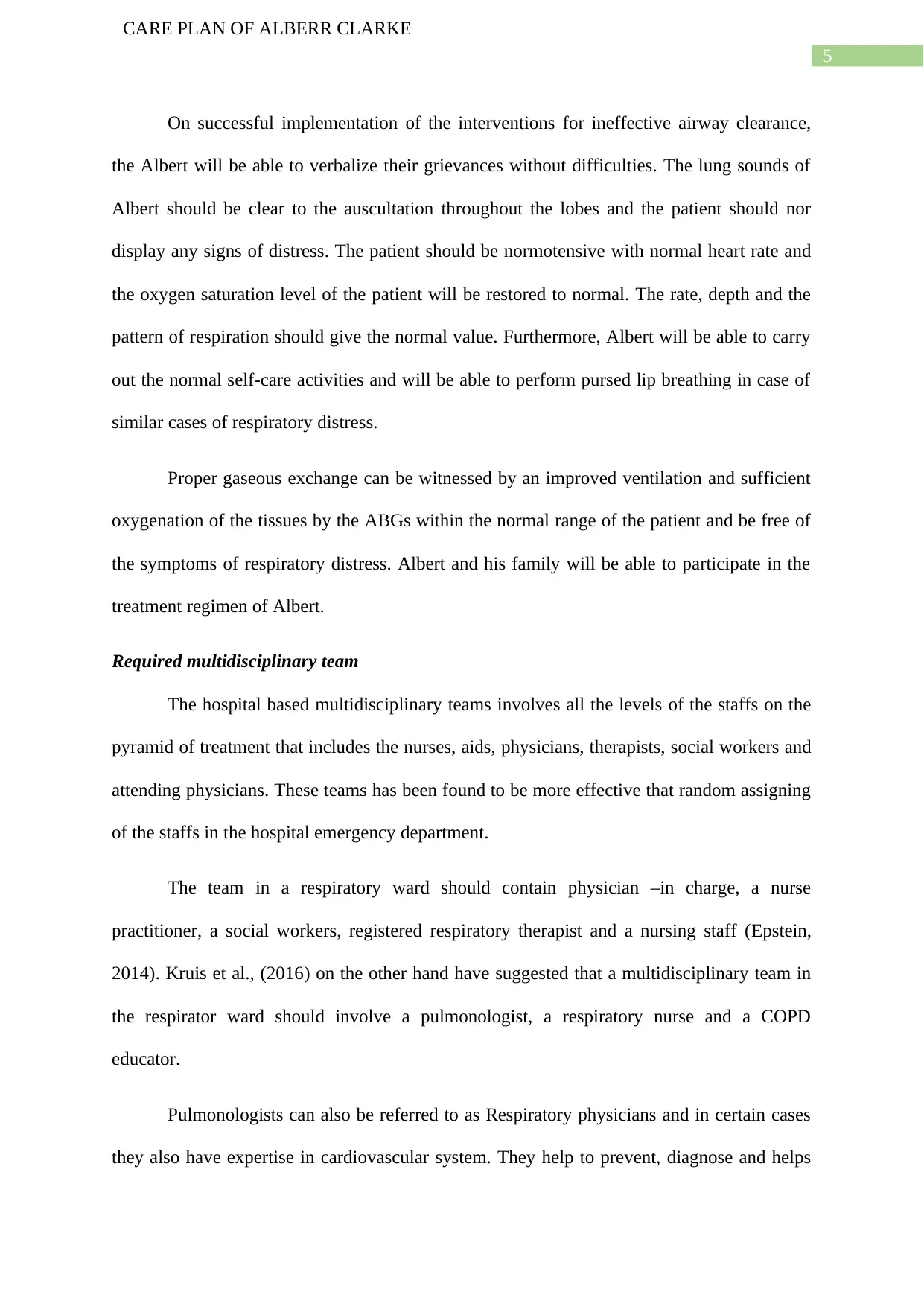
5
CARE PLAN OF ALBERR CLARKE
On successful implementation of the interventions for ineffective airway clearance,
the Albert will be able to verbalize their grievances without difficulties. The lung sounds of
Albert should be clear to the auscultation throughout the lobes and the patient should nor
display any signs of distress. The patient should be normotensive with normal heart rate and
the oxygen saturation level of the patient will be restored to normal. The rate, depth and the
pattern of respiration should give the normal value. Furthermore, Albert will be able to carry
out the normal self-care activities and will be able to perform pursed lip breathing in case of
similar cases of respiratory distress.
Proper gaseous exchange can be witnessed by an improved ventilation and sufficient
oxygenation of the tissues by the ABGs within the normal range of the patient and be free of
the symptoms of respiratory distress. Albert and his family will be able to participate in the
treatment regimen of Albert.
Required multidisciplinary team
The hospital based multidisciplinary teams involves all the levels of the staffs on the
pyramid of treatment that includes the nurses, aids, physicians, therapists, social workers and
attending physicians. These teams has been found to be more effective that random assigning
of the staffs in the hospital emergency department.
The team in a respiratory ward should contain physician –in charge, a nurse
practitioner, a social workers, registered respiratory therapist and a nursing staff (Epstein,
2014). Kruis et al., (2016) on the other hand have suggested that a multidisciplinary team in
the respirator ward should involve a pulmonologist, a respiratory nurse and a COPD
educator.
Pulmonologists can also be referred to as Respiratory physicians and in certain cases
they also have expertise in cardiovascular system. They help to prevent, diagnose and helps
CARE PLAN OF ALBERR CLARKE
On successful implementation of the interventions for ineffective airway clearance,
the Albert will be able to verbalize their grievances without difficulties. The lung sounds of
Albert should be clear to the auscultation throughout the lobes and the patient should nor
display any signs of distress. The patient should be normotensive with normal heart rate and
the oxygen saturation level of the patient will be restored to normal. The rate, depth and the
pattern of respiration should give the normal value. Furthermore, Albert will be able to carry
out the normal self-care activities and will be able to perform pursed lip breathing in case of
similar cases of respiratory distress.
Proper gaseous exchange can be witnessed by an improved ventilation and sufficient
oxygenation of the tissues by the ABGs within the normal range of the patient and be free of
the symptoms of respiratory distress. Albert and his family will be able to participate in the
treatment regimen of Albert.
Required multidisciplinary team
The hospital based multidisciplinary teams involves all the levels of the staffs on the
pyramid of treatment that includes the nurses, aids, physicians, therapists, social workers and
attending physicians. These teams has been found to be more effective that random assigning
of the staffs in the hospital emergency department.
The team in a respiratory ward should contain physician –in charge, a nurse
practitioner, a social workers, registered respiratory therapist and a nursing staff (Epstein,
2014). Kruis et al., (2016) on the other hand have suggested that a multidisciplinary team in
the respirator ward should involve a pulmonologist, a respiratory nurse and a COPD
educator.
Pulmonologists can also be referred to as Respiratory physicians and in certain cases
they also have expertise in cardiovascular system. They help to prevent, diagnose and helps
⊘ This is a preview!⊘
Do you want full access?
Subscribe today to unlock all pages.

Trusted by 1+ million students worldwide
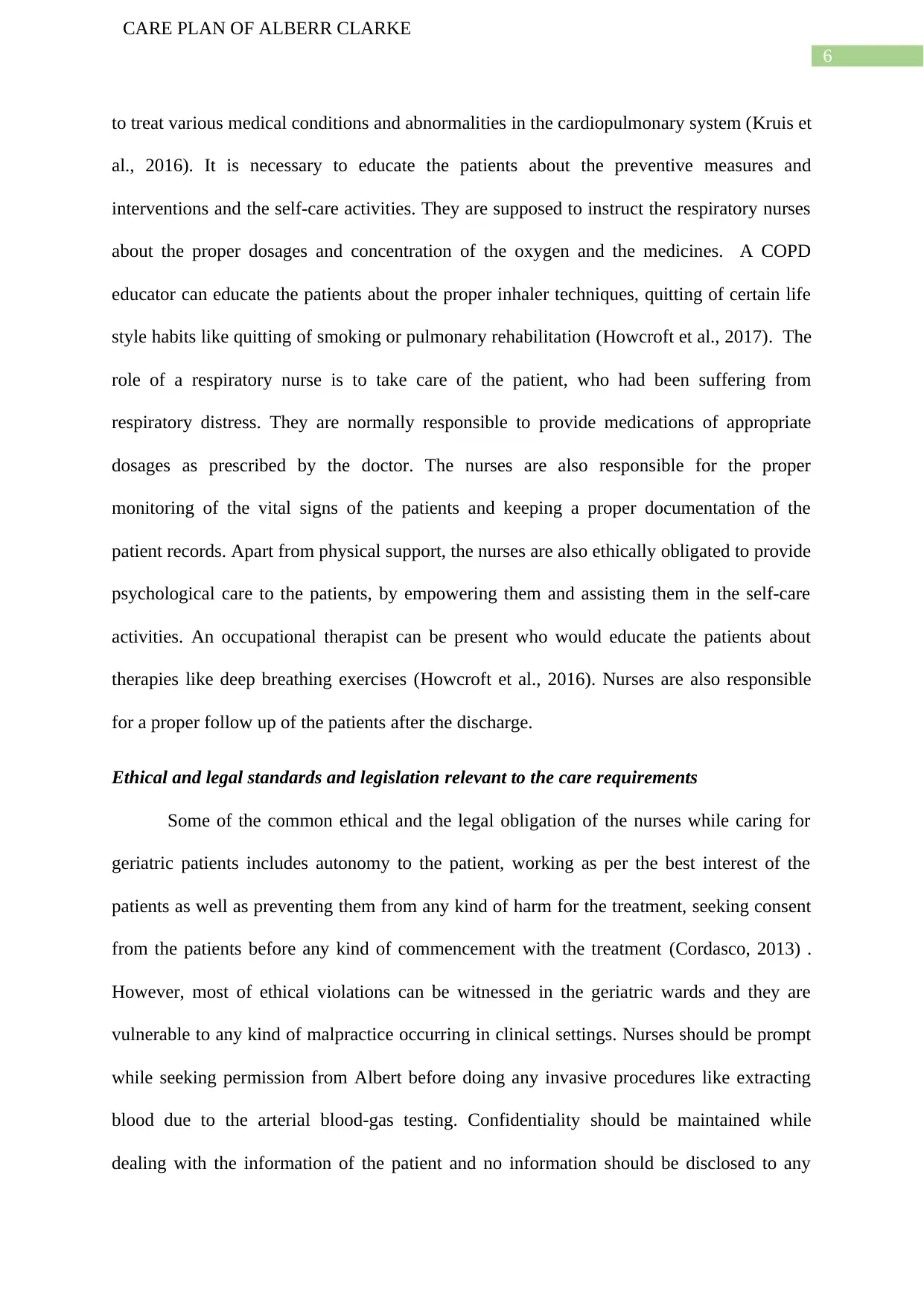
6
CARE PLAN OF ALBERR CLARKE
to treat various medical conditions and abnormalities in the cardiopulmonary system (Kruis et
al., 2016). It is necessary to educate the patients about the preventive measures and
interventions and the self-care activities. They are supposed to instruct the respiratory nurses
about the proper dosages and concentration of the oxygen and the medicines. A COPD
educator can educate the patients about the proper inhaler techniques, quitting of certain life
style habits like quitting of smoking or pulmonary rehabilitation (Howcroft et al., 2017). The
role of a respiratory nurse is to take care of the patient, who had been suffering from
respiratory distress. They are normally responsible to provide medications of appropriate
dosages as prescribed by the doctor. The nurses are also responsible for the proper
monitoring of the vital signs of the patients and keeping a proper documentation of the
patient records. Apart from physical support, the nurses are also ethically obligated to provide
psychological care to the patients, by empowering them and assisting them in the self-care
activities. An occupational therapist can be present who would educate the patients about
therapies like deep breathing exercises (Howcroft et al., 2016). Nurses are also responsible
for a proper follow up of the patients after the discharge.
Ethical and legal standards and legislation relevant to the care requirements
Some of the common ethical and the legal obligation of the nurses while caring for
geriatric patients includes autonomy to the patient, working as per the best interest of the
patients as well as preventing them from any kind of harm for the treatment, seeking consent
from the patients before any kind of commencement with the treatment (Cordasco, 2013) .
However, most of ethical violations can be witnessed in the geriatric wards and they are
vulnerable to any kind of malpractice occurring in clinical settings. Nurses should be prompt
while seeking permission from Albert before doing any invasive procedures like extracting
blood due to the arterial blood-gas testing. Confidentiality should be maintained while
dealing with the information of the patient and no information should be disclosed to any
CARE PLAN OF ALBERR CLARKE
to treat various medical conditions and abnormalities in the cardiopulmonary system (Kruis et
al., 2016). It is necessary to educate the patients about the preventive measures and
interventions and the self-care activities. They are supposed to instruct the respiratory nurses
about the proper dosages and concentration of the oxygen and the medicines. A COPD
educator can educate the patients about the proper inhaler techniques, quitting of certain life
style habits like quitting of smoking or pulmonary rehabilitation (Howcroft et al., 2017). The
role of a respiratory nurse is to take care of the patient, who had been suffering from
respiratory distress. They are normally responsible to provide medications of appropriate
dosages as prescribed by the doctor. The nurses are also responsible for the proper
monitoring of the vital signs of the patients and keeping a proper documentation of the
patient records. Apart from physical support, the nurses are also ethically obligated to provide
psychological care to the patients, by empowering them and assisting them in the self-care
activities. An occupational therapist can be present who would educate the patients about
therapies like deep breathing exercises (Howcroft et al., 2016). Nurses are also responsible
for a proper follow up of the patients after the discharge.
Ethical and legal standards and legislation relevant to the care requirements
Some of the common ethical and the legal obligation of the nurses while caring for
geriatric patients includes autonomy to the patient, working as per the best interest of the
patients as well as preventing them from any kind of harm for the treatment, seeking consent
from the patients before any kind of commencement with the treatment (Cordasco, 2013) .
However, most of ethical violations can be witnessed in the geriatric wards and they are
vulnerable to any kind of malpractice occurring in clinical settings. Nurses should be prompt
while seeking permission from Albert before doing any invasive procedures like extracting
blood due to the arterial blood-gas testing. Confidentiality should be maintained while
dealing with the information of the patient and no information should be disclosed to any
Paraphrase This Document
Need a fresh take? Get an instant paraphrase of this document with our AI Paraphraser
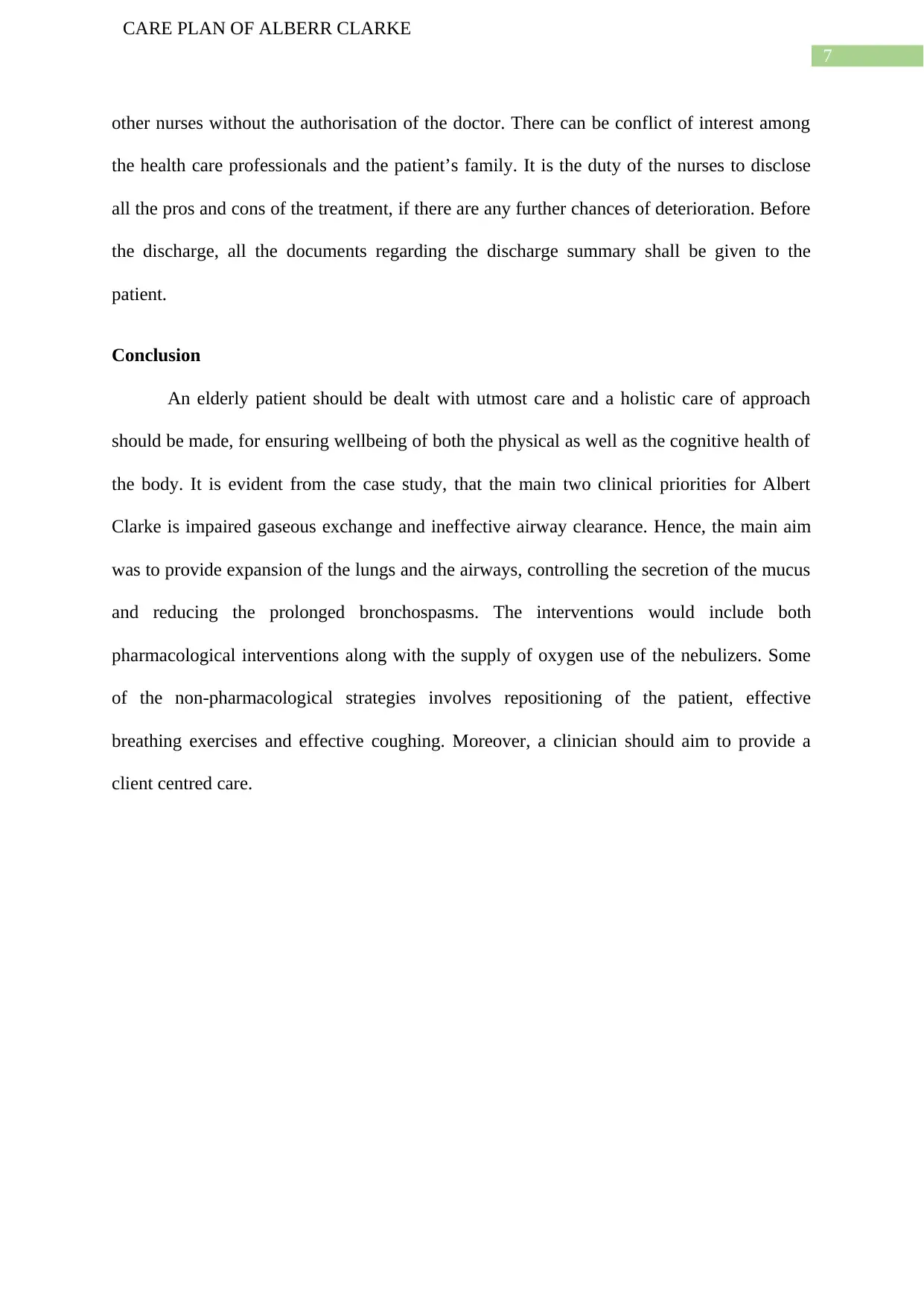
7
CARE PLAN OF ALBERR CLARKE
other nurses without the authorisation of the doctor. There can be conflict of interest among
the health care professionals and the patient’s family. It is the duty of the nurses to disclose
all the pros and cons of the treatment, if there are any further chances of deterioration. Before
the discharge, all the documents regarding the discharge summary shall be given to the
patient.
Conclusion
An elderly patient should be dealt with utmost care and a holistic care of approach
should be made, for ensuring wellbeing of both the physical as well as the cognitive health of
the body. It is evident from the case study, that the main two clinical priorities for Albert
Clarke is impaired gaseous exchange and ineffective airway clearance. Hence, the main aim
was to provide expansion of the lungs and the airways, controlling the secretion of the mucus
and reducing the prolonged bronchospasms. The interventions would include both
pharmacological interventions along with the supply of oxygen use of the nebulizers. Some
of the non-pharmacological strategies involves repositioning of the patient, effective
breathing exercises and effective coughing. Moreover, a clinician should aim to provide a
client centred care.
CARE PLAN OF ALBERR CLARKE
other nurses without the authorisation of the doctor. There can be conflict of interest among
the health care professionals and the patient’s family. It is the duty of the nurses to disclose
all the pros and cons of the treatment, if there are any further chances of deterioration. Before
the discharge, all the documents regarding the discharge summary shall be given to the
patient.
Conclusion
An elderly patient should be dealt with utmost care and a holistic care of approach
should be made, for ensuring wellbeing of both the physical as well as the cognitive health of
the body. It is evident from the case study, that the main two clinical priorities for Albert
Clarke is impaired gaseous exchange and ineffective airway clearance. Hence, the main aim
was to provide expansion of the lungs and the airways, controlling the secretion of the mucus
and reducing the prolonged bronchospasms. The interventions would include both
pharmacological interventions along with the supply of oxygen use of the nebulizers. Some
of the non-pharmacological strategies involves repositioning of the patient, effective
breathing exercises and effective coughing. Moreover, a clinician should aim to provide a
client centred care.
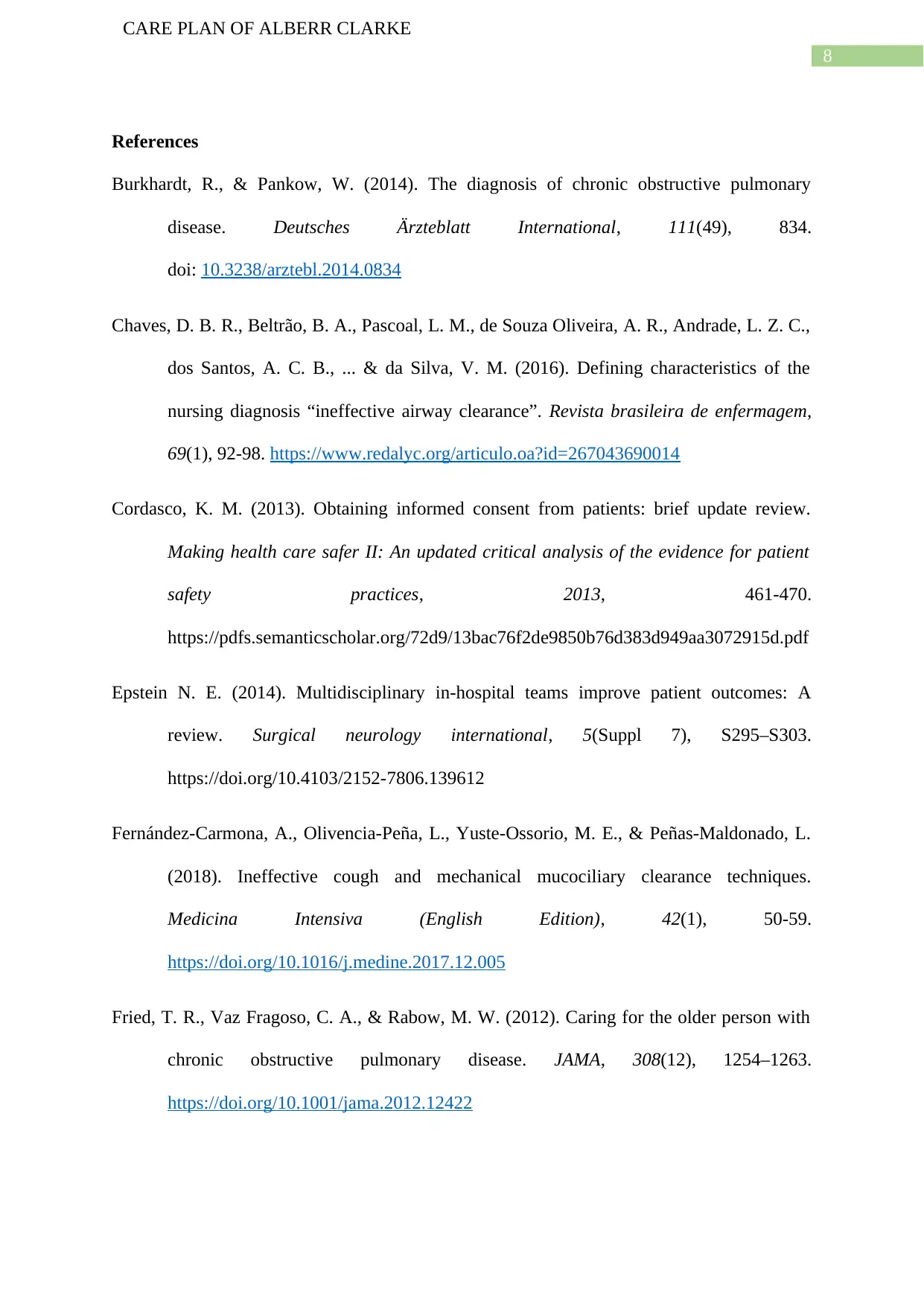
8
CARE PLAN OF ALBERR CLARKE
References
Burkhardt, R., & Pankow, W. (2014). The diagnosis of chronic obstructive pulmonary
disease. Deutsches Ärzteblatt International, 111(49), 834.
doi: 10.3238/arztebl.2014.0834
Chaves, D. B. R., Beltrão, B. A., Pascoal, L. M., de Souza Oliveira, A. R., Andrade, L. Z. C.,
dos Santos, A. C. B., ... & da Silva, V. M. (2016). Defining characteristics of the
nursing diagnosis “ineffective airway clearance”. Revista brasileira de enfermagem,
69(1), 92-98. https://www.redalyc.org/articulo.oa?id=267043690014
Cordasco, K. M. (2013). Obtaining informed consent from patients: brief update review.
Making health care safer II: An updated critical analysis of the evidence for patient
safety practices, 2013, 461-470.
https://pdfs.semanticscholar.org/72d9/13bac76f2de9850b76d383d949aa3072915d.pdf
Epstein N. E. (2014). Multidisciplinary in-hospital teams improve patient outcomes: A
review. Surgical neurology international, 5(Suppl 7), S295–S303.
https://doi.org/10.4103/2152-7806.139612
Fernández-Carmona, A., Olivencia-Peña, L., Yuste-Ossorio, M. E., & Peñas-Maldonado, L.
(2018). Ineffective cough and mechanical mucociliary clearance techniques.
Medicina Intensiva (English Edition), 42(1), 50-59.
https://doi.org/10.1016/j.medine.2017.12.005
Fried, T. R., Vaz Fragoso, C. A., & Rabow, M. W. (2012). Caring for the older person with
chronic obstructive pulmonary disease. JAMA, 308(12), 1254–1263.
https://doi.org/10.1001/jama.2012.12422
CARE PLAN OF ALBERR CLARKE
References
Burkhardt, R., & Pankow, W. (2014). The diagnosis of chronic obstructive pulmonary
disease. Deutsches Ärzteblatt International, 111(49), 834.
doi: 10.3238/arztebl.2014.0834
Chaves, D. B. R., Beltrão, B. A., Pascoal, L. M., de Souza Oliveira, A. R., Andrade, L. Z. C.,
dos Santos, A. C. B., ... & da Silva, V. M. (2016). Defining characteristics of the
nursing diagnosis “ineffective airway clearance”. Revista brasileira de enfermagem,
69(1), 92-98. https://www.redalyc.org/articulo.oa?id=267043690014
Cordasco, K. M. (2013). Obtaining informed consent from patients: brief update review.
Making health care safer II: An updated critical analysis of the evidence for patient
safety practices, 2013, 461-470.
https://pdfs.semanticscholar.org/72d9/13bac76f2de9850b76d383d949aa3072915d.pdf
Epstein N. E. (2014). Multidisciplinary in-hospital teams improve patient outcomes: A
review. Surgical neurology international, 5(Suppl 7), S295–S303.
https://doi.org/10.4103/2152-7806.139612
Fernández-Carmona, A., Olivencia-Peña, L., Yuste-Ossorio, M. E., & Peñas-Maldonado, L.
(2018). Ineffective cough and mechanical mucociliary clearance techniques.
Medicina Intensiva (English Edition), 42(1), 50-59.
https://doi.org/10.1016/j.medine.2017.12.005
Fried, T. R., Vaz Fragoso, C. A., & Rabow, M. W. (2012). Caring for the older person with
chronic obstructive pulmonary disease. JAMA, 308(12), 1254–1263.
https://doi.org/10.1001/jama.2012.12422
⊘ This is a preview!⊘
Do you want full access?
Subscribe today to unlock all pages.

Trusted by 1+ million students worldwide
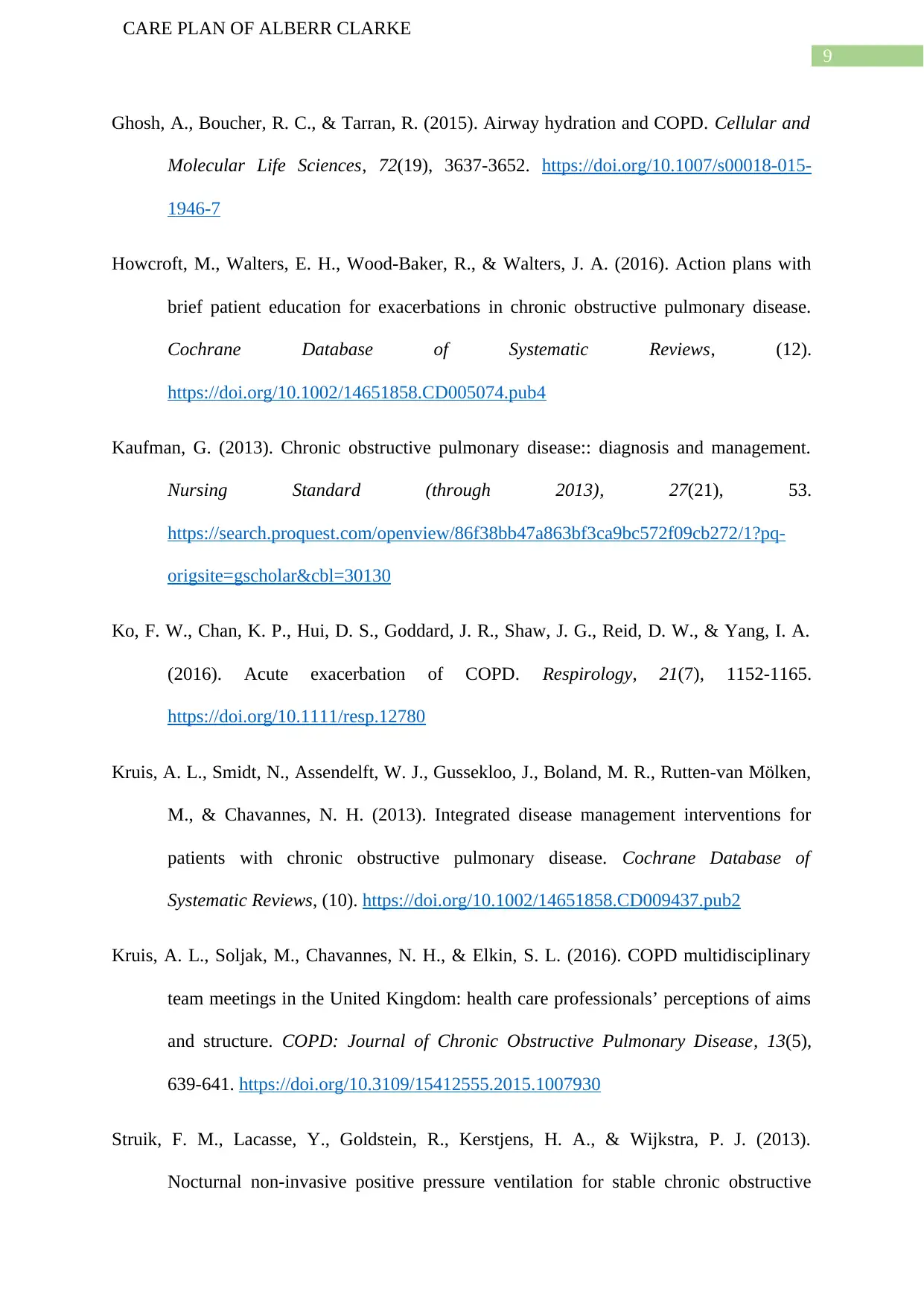
9
CARE PLAN OF ALBERR CLARKE
Ghosh, A., Boucher, R. C., & Tarran, R. (2015). Airway hydration and COPD. Cellular and
Molecular Life Sciences, 72(19), 3637-3652. https://doi.org/10.1007/s00018-015-
1946-7
Howcroft, M., Walters, E. H., Wood‐Baker, R., & Walters, J. A. (2016). Action plans with
brief patient education for exacerbations in chronic obstructive pulmonary disease.
Cochrane Database of Systematic Reviews, (12).
https://doi.org/10.1002/14651858.CD005074.pub4
Kaufman, G. (2013). Chronic obstructive pulmonary disease:: diagnosis and management.
Nursing Standard (through 2013), 27(21), 53.
https://search.proquest.com/openview/86f38bb47a863bf3ca9bc572f09cb272/1?pq-
origsite=gscholar&cbl=30130
Ko, F. W., Chan, K. P., Hui, D. S., Goddard, J. R., Shaw, J. G., Reid, D. W., & Yang, I. A.
(2016). Acute exacerbation of COPD. Respirology, 21(7), 1152-1165.
https://doi.org/10.1111/resp.12780
Kruis, A. L., Smidt, N., Assendelft, W. J., Gussekloo, J., Boland, M. R., Rutten‐van Mölken,
M., & Chavannes, N. H. (2013). Integrated disease management interventions for
patients with chronic obstructive pulmonary disease. Cochrane Database of
Systematic Reviews, (10). https://doi.org/10.1002/14651858.CD009437.pub2
Kruis, A. L., Soljak, M., Chavannes, N. H., & Elkin, S. L. (2016). COPD multidisciplinary
team meetings in the United Kingdom: health care professionals’ perceptions of aims
and structure. COPD: Journal of Chronic Obstructive Pulmonary Disease, 13(5),
639-641. https://doi.org/10.3109/15412555.2015.1007930
Struik, F. M., Lacasse, Y., Goldstein, R., Kerstjens, H. A., & Wijkstra, P. J. (2013).
Nocturnal non‐invasive positive pressure ventilation for stable chronic obstructive
CARE PLAN OF ALBERR CLARKE
Ghosh, A., Boucher, R. C., & Tarran, R. (2015). Airway hydration and COPD. Cellular and
Molecular Life Sciences, 72(19), 3637-3652. https://doi.org/10.1007/s00018-015-
1946-7
Howcroft, M., Walters, E. H., Wood‐Baker, R., & Walters, J. A. (2016). Action plans with
brief patient education for exacerbations in chronic obstructive pulmonary disease.
Cochrane Database of Systematic Reviews, (12).
https://doi.org/10.1002/14651858.CD005074.pub4
Kaufman, G. (2013). Chronic obstructive pulmonary disease:: diagnosis and management.
Nursing Standard (through 2013), 27(21), 53.
https://search.proquest.com/openview/86f38bb47a863bf3ca9bc572f09cb272/1?pq-
origsite=gscholar&cbl=30130
Ko, F. W., Chan, K. P., Hui, D. S., Goddard, J. R., Shaw, J. G., Reid, D. W., & Yang, I. A.
(2016). Acute exacerbation of COPD. Respirology, 21(7), 1152-1165.
https://doi.org/10.1111/resp.12780
Kruis, A. L., Smidt, N., Assendelft, W. J., Gussekloo, J., Boland, M. R., Rutten‐van Mölken,
M., & Chavannes, N. H. (2013). Integrated disease management interventions for
patients with chronic obstructive pulmonary disease. Cochrane Database of
Systematic Reviews, (10). https://doi.org/10.1002/14651858.CD009437.pub2
Kruis, A. L., Soljak, M., Chavannes, N. H., & Elkin, S. L. (2016). COPD multidisciplinary
team meetings in the United Kingdom: health care professionals’ perceptions of aims
and structure. COPD: Journal of Chronic Obstructive Pulmonary Disease, 13(5),
639-641. https://doi.org/10.3109/15412555.2015.1007930
Struik, F. M., Lacasse, Y., Goldstein, R., Kerstjens, H. A., & Wijkstra, P. J. (2013).
Nocturnal non‐invasive positive pressure ventilation for stable chronic obstructive
Paraphrase This Document
Need a fresh take? Get an instant paraphrase of this document with our AI Paraphraser
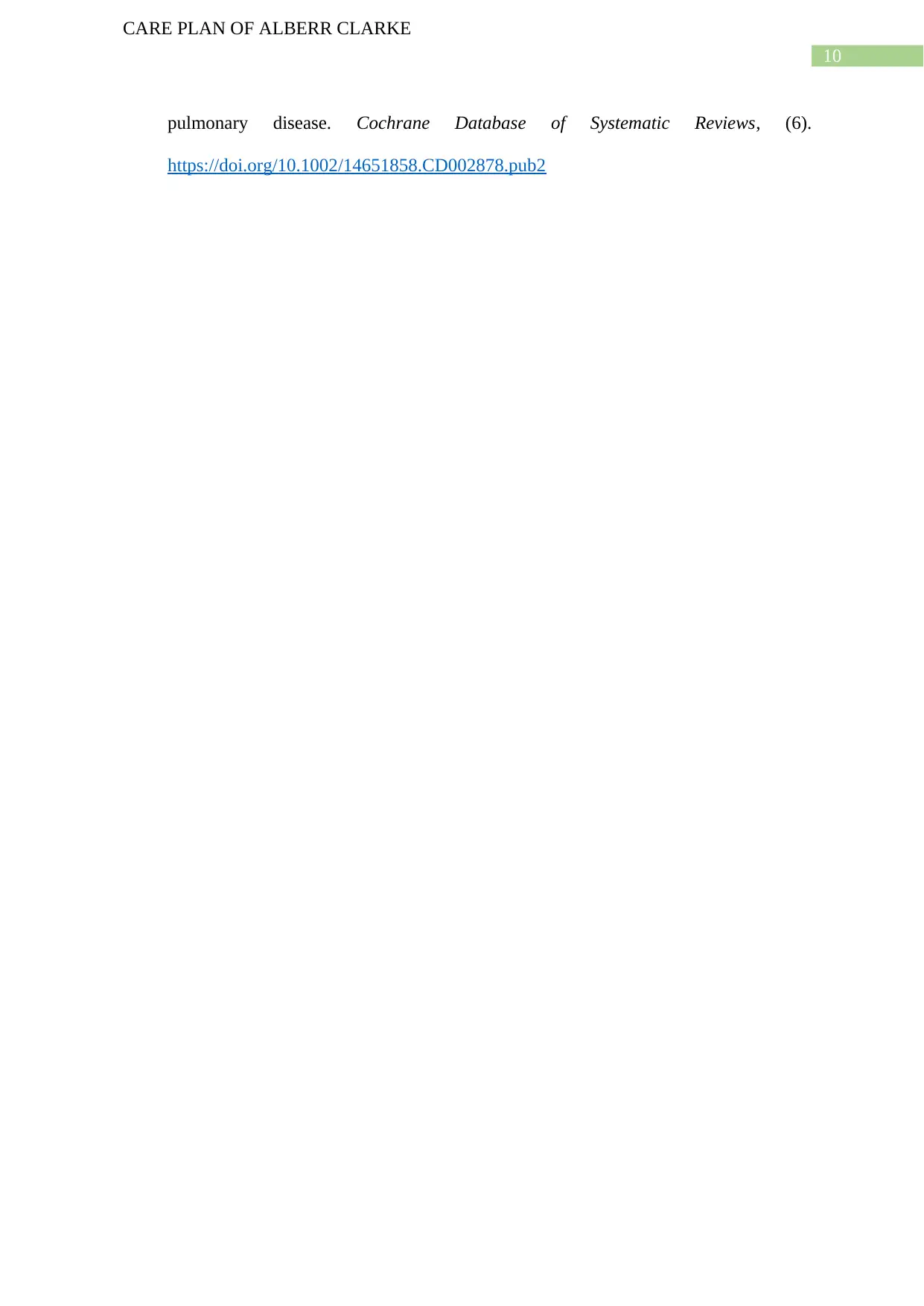
10
CARE PLAN OF ALBERR CLARKE
pulmonary disease. Cochrane Database of Systematic Reviews, (6).
https://doi.org/10.1002/14651858.CD002878.pub2
CARE PLAN OF ALBERR CLARKE
pulmonary disease. Cochrane Database of Systematic Reviews, (6).
https://doi.org/10.1002/14651858.CD002878.pub2
1 out of 11
Related Documents
Your All-in-One AI-Powered Toolkit for Academic Success.
+13062052269
info@desklib.com
Available 24*7 on WhatsApp / Email
![[object Object]](/_next/static/media/star-bottom.7253800d.svg)
Unlock your academic potential
Copyright © 2020–2025 A2Z Services. All Rights Reserved. Developed and managed by ZUCOL.





